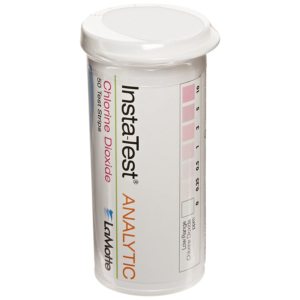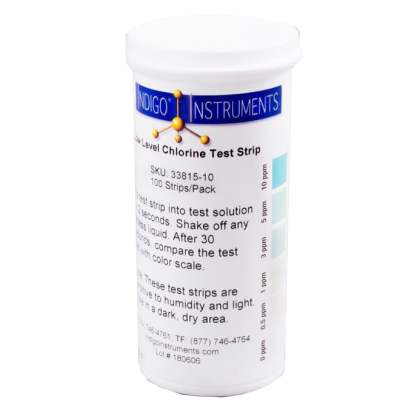- The strips are designed for user convenience, requiring no additional equipment and providing results within seconds.
- The Peroxide Test Strip will turn a progressively darker shade of blue depending on the concentration of peroxide in the mixture.
- Obtain straightforward measurements at 0, 1, 3, 10, 50, and 100 ppm.
-
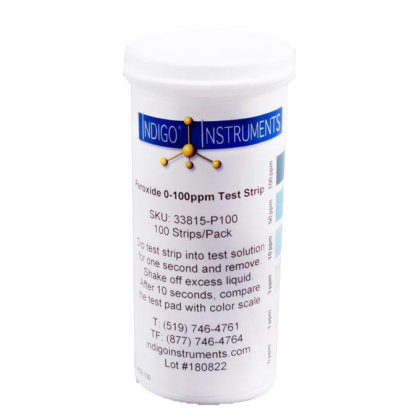 These Low-level Peroxide Test Strips are used to identify remaining peroxides in water that has been treated with peroxide as a disinfectant. These test strips deliver quick results in seconds and are calibrated to 0, 1, 3, 10, 50, and 100 ppm for accurate readings.
These Low-level Peroxide Test Strips are used to identify remaining peroxides in water that has been treated with peroxide as a disinfectant. These test strips deliver quick results in seconds and are calibrated to 0, 1, 3, 10, 50, and 100 ppm for accurate readings. -
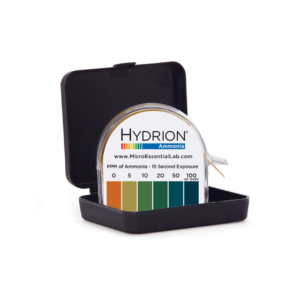 Hydrion Ammonia Test Strips provide a simple and economical means of measuring the ammonia concentration in the environment. These test strips are compliant with local animal welfare programs. Simply wet the strip with some water and wave it in the air. After 10-15 seconds compare the colour of the strip against the colour of the chart.
Hydrion Ammonia Test Strips provide a simple and economical means of measuring the ammonia concentration in the environment. These test strips are compliant with local animal welfare programs. Simply wet the strip with some water and wave it in the air. After 10-15 seconds compare the colour of the strip against the colour of the chart. -
 Stalosan F is designed to uniquely meet the hygiene needs of the modern poultry industry. It kills a wide range of pathogens, including bacteria, viruses, fungi, parasites, and flies. Stalosan F also plays an important role in your birds’ environment as a litter conditioner. It is effective in improving air quality and neutralizing harmful substances such as ammonia and hydrogen sulfide. MSDS
Stalosan F is designed to uniquely meet the hygiene needs of the modern poultry industry. It kills a wide range of pathogens, including bacteria, viruses, fungi, parasites, and flies. Stalosan F also plays an important role in your birds’ environment as a litter conditioner. It is effective in improving air quality and neutralizing harmful substances such as ammonia and hydrogen sulfide. MSDS -
 For control of the lesser mealworm (the darkling beetles Alphitobius diaperinus) and other listed pests ACTIVE INGREDIENT: Tetrachlorvinphos - 50% w/w In case of spills, poisoning or fire, call your provincial emergency response line.
For control of the lesser mealworm (the darkling beetles Alphitobius diaperinus) and other listed pests ACTIVE INGREDIENT: Tetrachlorvinphos - 50% w/w In case of spills, poisoning or fire, call your provincial emergency response line.DIRECTIONS FOR USE
Use Debantic 50WP as part of an overall integrated pest management (IPM) program. Debantic 50WP Insecticide Poultry and Livestock Premise Spray is suitable for use in conventional power or low pressure knapsack sprayers. Agitation is recommended to prevent undue settling of the suspension. Follow the USE DIRECTIONS for the proper percent solution needed for a specific insect and areas or types of wall surfaces. Refer to DILUTION TABLE for the quantity of insecticide needed to make the percent solution recommended. PREMISES USE DIRECTIONSPOULTRY USE DIRECTIONS (DO NOT APPLY TO RESIDENCES)INSECT PROBLEM AREAS % SOLUTION REMARKS Flies Dairy barns, poultry houses, swine barns, other animal buildings. 2.0% For dry whitewashed wood or concrete block surfaces, apply 8 litres of solution/100 sq. m. 1.0% For unpainted wood or painted concrete block surfaces, apply 8 litres of solution/100 sq. m. 1.0% For masonite or galvanized sheet metal surfaces, apply 4 litres of solution/100 sq. m. Maggots Poultry droppings, manure piles, garbage piles, under feed troughs 1.0% Apply 4 litres of solution/10 sq. m. Penetrate problem area first time - repeat every 7-10 days thereafter. DILUTION TABLEINSECT TYPE OF HOUSING % SOLUTION REMARKS Lice & Mites Wire Cages 0.5% Apply directly to birds (4 litres/100 birds). Spray vent and fluff areas from below. Repeat when necessary. Do not repeat more often than every 14 days. For individual bird treatment, apply 30 mL of the mixture per bird. NOTE: For maximum lasting control of the northern fowl mite, penetration of the feathers around the vent area is essential. Use power sprayer at 7-9 kg/sq cm at no less than recommended pressure. More attention must be given to each individual bird when using low-pressure equipment. Treat roosters carefully and thoroughly to avoid re-infestation in breeding flocks. Floor Management Dust Box 50% WP Mix evenly throughout top layer of box contents using 150 g/100 birds. Lice, Mite & Larvae and adults of the lesser mealworm (the darkling beetle, Alphitobius diaperinus) Floor Management Roost Paint 1.0% Treat with brush or spray thoroughly, particularly cracks and crevices using 145-165 mL/10 m. Floor Management Litter 1.0% Apply 1-4 litres/100 sq. m. evenly for penetration to litter surface. Also apply thoroughly to walls, roost, cracks, crevices and interiors. Spray birds lightly. Floor Management Litter 50% WP Treat evenly and thoroughly using 75 g/10 sq. m. Use a rotary or mechanical duster. (Wear dust mask during this operation). Fowl Tick All Types 1.0% Apply 3-4 litres/10 sq. m. thoroughly to walls, ceilings, floor cracks and crevices with a power sprayer. PRECAUTIONS KEEP OUT OF REACH OF CHILDREN AND LIVESTOCK. Harmful if swallowed or absorbed through skin. Avoid breathing spray mist and dust. Do not get in eyes, on skin, or on clothing. Wash thoroughly with soap and water after handling and before eating or smoking. Avoid contamination of feed and foodstuffs. Store apart from food and feed in a cool place. This product is toxic to fish. Do not contaminate water by disposal of this product. Do not re-use empty container. FIRST AID IF SWALLOWED: Call a poison control centre or doctor immediately for treatment advice. Have person sip a glass of water if able to swallow. Do not induce vomiting unless told to do so by a poison control centre or doctor. Do not give anything by mouth to an unconscious person. IF INHALED: Move person to fresh air. If person is not breathing, call 911 or an ambulance, then give artificial respiration, preferably by mouth-to-mouth, if possible. Call a poison control centre or doctor for further treatment advice. IF ON SKIN OR CLOTHING: Take off contaminated clothing. Rinse skin immediately with plenty of water for 15-20 minutes. Call a poison control centre or doctor for treatment advice. IF IN EYES: Hold eye open and rinse slowly and gently with water for 15-20 minutes. Remove contact lenses if present, after the first 5 minutes, then continue rinsing eye. Call a poison control centre or doctor for treatment advice. Take container, label or product name and Pest Control Product Registration Number with you when seeking medical attention. TOXICOLOGICAL INFORMATION Tetrachlorvinphos is a cholinesterase inhibitor. Typical symptoms of overexposure to cholinesterase inhibitors include headache, nausea, dizziness, sweating, salivation, runny nose and eyes. This may progress to muscle twitching, weakness, tremor, incoordination, vomiting, abdominal cramps and diarrhea in more serious poisonings. A life-threatening poisoning is signified by loss of consciousness, incontinence, convulsions and respiratory depression with a secondary cardiovascular component. Treat symptomatically. If exposed, plasma and red blood cell cholinesterase tests may indicate degree of exposure (baseline data are useful). Atropine, only by injection, is the preferable antidote. Oximes, such as Pralidoxime Chloride, may be therapeutic if used early; however, use only in conjunction with atropine. In cases of severe acute poisoning, use antidotes immediately after establishing an open airway and respiration. With oral exposure, the decision of whether to induce vomiting or not should be made by an attending physician. DISPOSAL 1. Triple-or pressure-rinse the empty container. Add the rinsings to the spray mixture in the tank. 2. Follow provincial instruction for any required additional cleaning of the container prior to its disposal. 3. Make the empty container unsuitable for further use. 4. Dispose of the container in accordance with provincial requirements. 5. For information on disposal of unused, unwanted product, contact the manufacturer or the provincial regulatory agency. Contact the manufacturer and the provincial regulatory agency in case of a spill and for clean-up of spills. MSDSAMOUNT (kg) OF 50% WETTABLE POWDER AMOUNT OF WATER 0.5% SOLUTION 1% SOLUTION 2% SOLUTION 1/4 kg 25 litres 12 1/2 litres 6 1/4 litres 1 100 litres 50 litres 25 litres 2 200 litres 100 litres 50 litres 4 400 litres 200 litres 100 litres -
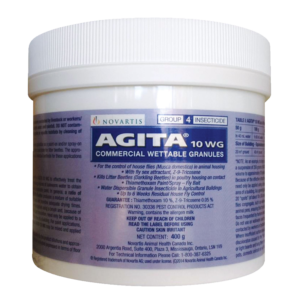 18 or more $44.99 each AGITA 10 WG is a new water dispersible residual insecticidal bait formulation for the control of house flies (Musca domestica) in agricultural buildings (e.g. barns, poultry houses, etc.). The novel combination of a neonicotinoid insecticide with both contact and stomach modes of action, with a house fly sex attractant and a bait, provides an effective fly bait formula which encourages both male and female house flies to remain in treated areas and consume or contact lethal doses of the product. This unique formulation affords the end user up to 6 weeks of residual activity when applied according to label directions. In addition, AGITA 10 WG kills litter beetles (Alphitobius diaperinus) on contact in broiler houses. AGITA 10 WG should be used as part of an integrated pest management program for insects. Directions for Use: General: Use any AGITA 10 WG suspension on the day of mixing, preferably immediately after preparation. Do not treat dirty, highly porous or newly whitewashed walls to prevent loss of long term efficacy. Do not apply on metal and glass surfaces to avoid excessive run-off. Treated surfaces may display a slight, discernible discolouration (white to beige film or powder) when dry, that permits applicators to identify treated surfaces and monitor the rate of bait consumption. Apply ONLY in locations not accessible to children, pets, domestic animals or wildlife, and ONLY on surfaces not routinely contacted by livestock or workers/bystanders. Protect from direct sunlight, water and rainfall. DO NOT contaminate irrigation or drinking water supplies or aquatic habitats by cleaning of equipment or disposal of wastes. AGITA 10 WG is a formulation suitable for application as a paint-on and/or spray-on insecticidal bait for house flies or a contact insecticide for litter beetles. The appropriate recommendations for use rates and individual methods for these applications are as follows: Paint-On for Adult Fly Control: Thoroughly mix the appropriate quantity of AGITA 10 WG to effectively treat the intended surface areas with a corresponding volume of lukewarm water to obtain a suspension with the consistency of a brushable paint. In general, a ratio of 125 grams of AGITA 10 WG per 100 mL of water produces a mixture of suitable consistency that effectively coats surfaces and provides adequate drying times. The freshly prepared suspension should be applied using a brush and, because of the highly attractive nature of the AGITA bait formulation, need only be applied to a small percentage of the available surface area of a building. For paint applications, a daily maximum quantity of 2.0 kg of AGITA 10 WG may be mixed and applied by one person. Because of the effective attractive nature of the AGITA formulation, the suspension need only be applied using a brush to a small percentage of the available surface area of a building. As a general guide, apply the suspension at a rate of approximately 20 “spots” (of about 10 x 30 cm each) per 100 m2 of ground surface, in areas where flies congregate, such as window sills, doors frames, warm wall areas and near animal pens, ensuring that the bait is kept out of reach of animals and away from surfaces frequented by humans and domestic pets. Stir occasionally during application. Do not use on walkways used by animals or on any surfaces that may be routinely contacted by workers or bystanders. Where insufficient surface area is available for painting or where some slight white discoloration caused by the “paint” is unacceptable, paint strips of cardboard, wood or light boards and hang them from the ceiling in locations not accessible to children, pets, domestic animals or wildlife. Spray-On for Adult Fly Control: For applications employing a low-pressure spray applicator, thoroughly mix the Fly Bait with lukewarm water at the ratio of 125 grams of AGITA 10 WG per 1000 mL of water to obtain a mixture of suitable consistency that will effectively coat surfaces while providing adequate drying times. Apply suspension using a standard course spray applicator to appropriate target locations of the wall/ceiling surface area. Again, because the effective attractive nature of the AGITA bait formulation, and unlike “traditional” agricultural fly wall sprays, the suspension need only be applied to a small percentage of the surface area of a building to provide effective fly control. The amount of diluted product required to treat a particular building will vary depending upon the nature of surface to be treated. Apply spray to the point of run-off, while avoiding excessive run-off, to areas where flies congregate, such as window sills/frames, door frames, warm wall areas and near animal pens, ensuring that the bait is kept out of reach of animals and away from surfaces frequented by humans and domestic pets. Stir occasionally during application. Do not use on walkways used by animals or on any surfaces that may be routinely contacted by workers or bystanders. Where insufficient surface area is available for bait application or where some slight discoloration caused by the spray is unacceptable, spray strips of cardboard, wood or light boards and hang them from the ceiling in locations not accessible to children, pets, domestic animals or wildlife. AGITA 10 WG may provide up to six weeks of residual activity, depending upon the size of the resident pest population, re-infestation or re-invasion from neighbouring farms, etc. Estimation of the amount of bait remaining can be determined by observation of the rate at which the slight discolouration of treated surfaces (slight whitish/beige “powder”) disappears. Re-apply the product, as necessary, so as to reduce the possibility of a resident fly population being re-established. The ultimate residual control afforded by AGITA 10 WG will depend upon the size and source of the resident fly population, the re-invasion rates from neighbouring agricultural practices, and the on-farm maintenance, sanitation and hygiene procedures and schedules (e.g. routine removal of fly breeding sites/material, etc.). It is always recommended that AGITA Fly Bait products be used as part of a complete integrated pest management program designed to minimize pest populations and optimize the housing conditions for economic animals. Directions for use against Litter Beetle in Broiler Houses (“Band Spray” Method): AGITA 10 WG kills litter beetles (Alphitobius diaperinus) by direct contact. Using the preparation methods detailed above, AGITA 10 WG should be applied as a suspension in a single 1m wide band at the rate of 4 grams per square metre of surface area (i.e. “band spray method” - ~ 2 to 3 X the house fly control rate). Ensure that the product is mixed with sufficient water to allow a thorough wetting of this 1m wide band on all sides of the broiler house (~1 L per 15 m2). The spray should be applied after cleaning of the facility and the placement of new litter, but just before the house is heated for the arrival of a new batch of chicks. The spray should be applied to the litter beetles’ primary migration routes towards the new litter. The area around any cracks or openings in the ceiling or walls should also be sprayed. The rationale for this program is the fact that the beetles hide in the ceiling or walls between cycles and then crawl out just before the new chicks arrive. At this point, therefore, they will come into contact with the spray band.
18 or more $44.99 each AGITA 10 WG is a new water dispersible residual insecticidal bait formulation for the control of house flies (Musca domestica) in agricultural buildings (e.g. barns, poultry houses, etc.). The novel combination of a neonicotinoid insecticide with both contact and stomach modes of action, with a house fly sex attractant and a bait, provides an effective fly bait formula which encourages both male and female house flies to remain in treated areas and consume or contact lethal doses of the product. This unique formulation affords the end user up to 6 weeks of residual activity when applied according to label directions. In addition, AGITA 10 WG kills litter beetles (Alphitobius diaperinus) on contact in broiler houses. AGITA 10 WG should be used as part of an integrated pest management program for insects. Directions for Use: General: Use any AGITA 10 WG suspension on the day of mixing, preferably immediately after preparation. Do not treat dirty, highly porous or newly whitewashed walls to prevent loss of long term efficacy. Do not apply on metal and glass surfaces to avoid excessive run-off. Treated surfaces may display a slight, discernible discolouration (white to beige film or powder) when dry, that permits applicators to identify treated surfaces and monitor the rate of bait consumption. Apply ONLY in locations not accessible to children, pets, domestic animals or wildlife, and ONLY on surfaces not routinely contacted by livestock or workers/bystanders. Protect from direct sunlight, water and rainfall. DO NOT contaminate irrigation or drinking water supplies or aquatic habitats by cleaning of equipment or disposal of wastes. AGITA 10 WG is a formulation suitable for application as a paint-on and/or spray-on insecticidal bait for house flies or a contact insecticide for litter beetles. The appropriate recommendations for use rates and individual methods for these applications are as follows: Paint-On for Adult Fly Control: Thoroughly mix the appropriate quantity of AGITA 10 WG to effectively treat the intended surface areas with a corresponding volume of lukewarm water to obtain a suspension with the consistency of a brushable paint. In general, a ratio of 125 grams of AGITA 10 WG per 100 mL of water produces a mixture of suitable consistency that effectively coats surfaces and provides adequate drying times. The freshly prepared suspension should be applied using a brush and, because of the highly attractive nature of the AGITA bait formulation, need only be applied to a small percentage of the available surface area of a building. For paint applications, a daily maximum quantity of 2.0 kg of AGITA 10 WG may be mixed and applied by one person. Because of the effective attractive nature of the AGITA formulation, the suspension need only be applied using a brush to a small percentage of the available surface area of a building. As a general guide, apply the suspension at a rate of approximately 20 “spots” (of about 10 x 30 cm each) per 100 m2 of ground surface, in areas where flies congregate, such as window sills, doors frames, warm wall areas and near animal pens, ensuring that the bait is kept out of reach of animals and away from surfaces frequented by humans and domestic pets. Stir occasionally during application. Do not use on walkways used by animals or on any surfaces that may be routinely contacted by workers or bystanders. Where insufficient surface area is available for painting or where some slight white discoloration caused by the “paint” is unacceptable, paint strips of cardboard, wood or light boards and hang them from the ceiling in locations not accessible to children, pets, domestic animals or wildlife. Spray-On for Adult Fly Control: For applications employing a low-pressure spray applicator, thoroughly mix the Fly Bait with lukewarm water at the ratio of 125 grams of AGITA 10 WG per 1000 mL of water to obtain a mixture of suitable consistency that will effectively coat surfaces while providing adequate drying times. Apply suspension using a standard course spray applicator to appropriate target locations of the wall/ceiling surface area. Again, because the effective attractive nature of the AGITA bait formulation, and unlike “traditional” agricultural fly wall sprays, the suspension need only be applied to a small percentage of the surface area of a building to provide effective fly control. The amount of diluted product required to treat a particular building will vary depending upon the nature of surface to be treated. Apply spray to the point of run-off, while avoiding excessive run-off, to areas where flies congregate, such as window sills/frames, door frames, warm wall areas and near animal pens, ensuring that the bait is kept out of reach of animals and away from surfaces frequented by humans and domestic pets. Stir occasionally during application. Do not use on walkways used by animals or on any surfaces that may be routinely contacted by workers or bystanders. Where insufficient surface area is available for bait application or where some slight discoloration caused by the spray is unacceptable, spray strips of cardboard, wood or light boards and hang them from the ceiling in locations not accessible to children, pets, domestic animals or wildlife. AGITA 10 WG may provide up to six weeks of residual activity, depending upon the size of the resident pest population, re-infestation or re-invasion from neighbouring farms, etc. Estimation of the amount of bait remaining can be determined by observation of the rate at which the slight discolouration of treated surfaces (slight whitish/beige “powder”) disappears. Re-apply the product, as necessary, so as to reduce the possibility of a resident fly population being re-established. The ultimate residual control afforded by AGITA 10 WG will depend upon the size and source of the resident fly population, the re-invasion rates from neighbouring agricultural practices, and the on-farm maintenance, sanitation and hygiene procedures and schedules (e.g. routine removal of fly breeding sites/material, etc.). It is always recommended that AGITA Fly Bait products be used as part of a complete integrated pest management program designed to minimize pest populations and optimize the housing conditions for economic animals. Directions for use against Litter Beetle in Broiler Houses (“Band Spray” Method): AGITA 10 WG kills litter beetles (Alphitobius diaperinus) by direct contact. Using the preparation methods detailed above, AGITA 10 WG should be applied as a suspension in a single 1m wide band at the rate of 4 grams per square metre of surface area (i.e. “band spray method” - ~ 2 to 3 X the house fly control rate). Ensure that the product is mixed with sufficient water to allow a thorough wetting of this 1m wide band on all sides of the broiler house (~1 L per 15 m2). The spray should be applied after cleaning of the facility and the placement of new litter, but just before the house is heated for the arrival of a new batch of chicks. The spray should be applied to the litter beetles’ primary migration routes towards the new litter. The area around any cracks or openings in the ceiling or walls should also be sprayed. The rationale for this program is the fact that the beetles hide in the ceiling or walls between cycles and then crawl out just before the new chicks arrive. At this point, therefore, they will come into contact with the spray band.Precautions
KEEP OUT OF REACH OF CHILDREN, PETS, DOMESTIC ANIMALS AND WILDLIFE. Avoid contact with skin, eyes and clothing. Avoid breathing spray mist. Wear coveralls over a long sleeved shirt and long pants, chemical-resistant gloves, shoes and socks when handling the product, clean-up and repair. Wear a NIOSH/MSHA-approved respirator when applying and a NIOSH/MSHA-approved dust-filtering mask during clean-up of the product that is not completely consumed. Wash exposed body parts and change clothing after handling, and before eating, drinking or smoking. Do not contaminate feed, water, food or litter through application or disposal of product. Do not apply bait where animals can lick the product. Prevent accidental transfer of the product, by people or animals, from treated areas to areas used by livestock. FIRST AID: IF SWALLOWED: Call a poison control centre or doctor immediately for treatment advice. Do not induce vomiting unless told to do so by a poison control centre or doctor. Do not give any liquid to the person. Do not give anything by mouth to an unconscious person. IF ON SKIN OR CLOTHING: Take off contaminated clothing. Rinse skin immediately with plenty of water for 15-20 minutes. Call a poison control centre or doctor for treatment advice. IF INHALED: Move person to fresh air. If person is not breathing, call 911 or an ambulance, then give artificial respiration, preferably by mouth-to-mouth, if possible. Call a poison control centre or doctor for further treatment advice. IF IN EYES: Hold eye open and rinse slowly and gently with water for 15-20 minutes. Remove contact lenses, if present, after the first 5 minutes, then continue rinsing eye. Call a poison control centre or doctor for treatment advice. Take container, label or product name and Pest Control Product Registration Number with you when seeking medical attention. TOXICOLOGICAL INFORMATION: There is no specific antidote for this product if ingested. If a large amount has been ingested and emesis is inadequate, lavage stomach. Treat symptomatically. ENVIRONMENTAL HAZARD: Toxic to bees. RESISTANCE MANAGEMENT: For resistance management, thiamethoxam is a Group 4 insecticide. Any house fly population may contain individuals naturally resistant to thiamethoxam and Group 4 insecticides. To delay insecticide resistance, avoid exclusive, repeated use of AGITA Fly Bait or other Group 4 insecticides. Keep accurate records of insecticides used in your operation. Keep the house fly population as low as possible by manure management.Storage
Store product in original, tightly sealed container. Store in a cool, dry place. Do not contaminate water, food or feed by storage or disposal. Do not reuse empty container.Disposal
1. Triple-or-pressure-rinse the empty container. Add the rinsings to the spray mixture in the tank. 2. Follow provincial instruction for any required additional cleaning of the container prior to its disposal. 3. Make the empty container unsuitable for further use. 4. Dispose of the container in accordance with provincial requirements. 5. For information on disposal of unused, unwanted product, contact the manufacturer or the provincial regulatory agency. Contact the manufacturer and the provincial regulatory agency in case of a spill, and for clean-up of spills. MSDS -
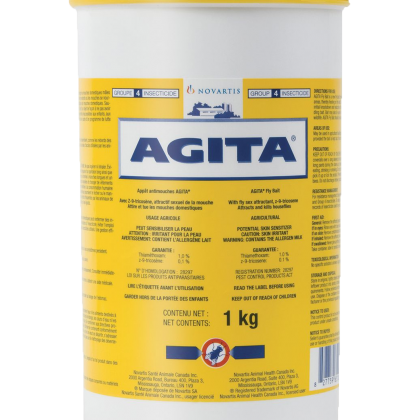 AGITA Fly Bait is a new fly bait formula containing a house fly sex attractant which encourages both male and female house flies to remain in the treated areas, thereby feeding on the bait. Bait should be scattered once per day over fly feeding areas and places where flies are known to congregate to provide initial knockdown and reduction of house fly populations. Scatter AGITA Fly Bait at a rate of 200 g per 100 m2 from a container or other device to avoid handling bait. Bait may also be used in hanging or stationary tamper-resistant bait boxes in locations not accessible to children, pets, domestic animals or wildlife. AGITA Fly Bait should be used as part of an integrated pest management program for house flies. AREAS OF USE: May be used in agricultural buildings (e.g. barns, poultry houses, etc.) in areas where house flies congregate such as windowsills and near animal pens, provided the bait is kept out of reach of animals. Do not use on walkways used by animals.
AGITA Fly Bait is a new fly bait formula containing a house fly sex attractant which encourages both male and female house flies to remain in the treated areas, thereby feeding on the bait. Bait should be scattered once per day over fly feeding areas and places where flies are known to congregate to provide initial knockdown and reduction of house fly populations. Scatter AGITA Fly Bait at a rate of 200 g per 100 m2 from a container or other device to avoid handling bait. Bait may also be used in hanging or stationary tamper-resistant bait boxes in locations not accessible to children, pets, domestic animals or wildlife. AGITA Fly Bait should be used as part of an integrated pest management program for house flies. AREAS OF USE: May be used in agricultural buildings (e.g. barns, poultry houses, etc.) in areas where house flies congregate such as windowsills and near animal pens, provided the bait is kept out of reach of animals. Do not use on walkways used by animals.Precautions
KEEP OUT OF REACH OF CHILDREN, PETS, DOMESTIC ANIMALS AND WILDLIFE. Do not ingest or inhale. Avoid contact with skin, eyes and clothing. Wear coveralls over a long-sleeved shirt and long pants, chemical-resistant gloves, shoes and socks when handling the product.Wear a NIOSH/MSHA-approved dust-filtering mask, long- sleeved shirt, long pants, shoes and socks during the clean up of product which is not completely consumed. Wash exposed body parts and change clothing after handling, and before eating, drinking or smoking. Do not contaminate feed, water, food or litter through application or disposal of product. Do not apply bait where animals can pick it up or lick the product. Prevent accidental transfer of the product, by people or animals, from treated areas to areas used by livestock. Harmful to bees. Do not discharge leftover product into ponds, streams or sewage systems. FIRST AID: If on skin or clothing: Take off contaminated clothing. Rinse skin immediately with plenty of water for 15-20 minutes. Call a poison control centre or doctor for treatment advice. If in eyes: Hold eye open and rinse slowly and gently with water for 15-20 minutes. Remove contact lenses, if present, after the first 5 minutes, then continue rinsing eye. Call a poison control centre or doctor for treatment advice. If swallowed: Call a poison control centre or doctor immediately for treatment advice. Have person sip a glass of water if able to swallow. Do not induce vomiting unless told to do so by a poison control centre or doctor. Do not give anything by mouth to an unconscious person. If inhaled: Move person to fresh air. If person is not breathing, call 911 or an ambulance, then give artificial respiration, preferably by mouth- to-mouth, if possible. Call a poison control centre or doctor for further treatment advice. Take container, label or product name and Pest Control Product Registration Number with you when seeking medical attention. TOXICOLOGICAL INFORMATION: No specific antidote is known. Apply symptomatic therapy. Induce emesis or lavage stomach. STORAGE AND DISPOSAL: Store in original, tightly closed containers. Protect from light and humidity. Do not contaminate water, food or feed by storage or disposal. Do not discharge leftover product into ponds, streams or sewage systems. Do not reuse empty container. Dispose of unused or spoiled bait in accordance with local requirements. Follow provincial instructions for any required cleaning of the container prior to its disposal. Make the empty container unsuitable for further use. Dispose of the container in accordance with provincial requirements. For information on disposal of unused, unwanted product, contact the manufacturer or the provincial regulatory agency. Contact the manufacturer and the provincial regulatory agency in case of a spill, and for the clean-up of spills. MSDS -
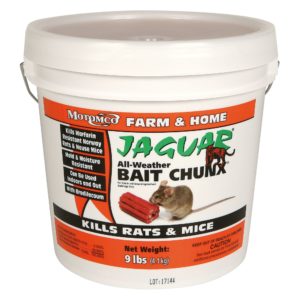 Jaguar All-Weather Bait Chunx contain the active ingredient Brodifacoum, Motomco's most powerful anticoagulant. Motomco's unique, proprietary extrusion process produces Bait Chunx with multiple edges that appeal to a rodent's desire to gnaw. Chunx are made with food-grade ingredients and small amounts of paraffin for a highly palatable bait. Jaguar Chunx are red in color and it's unique shape can be easily placed on rods in a bait station or secured using nails or wire. MSDS
Jaguar All-Weather Bait Chunx contain the active ingredient Brodifacoum, Motomco's most powerful anticoagulant. Motomco's unique, proprietary extrusion process produces Bait Chunx with multiple edges that appeal to a rodent's desire to gnaw. Chunx are made with food-grade ingredients and small amounts of paraffin for a highly palatable bait. Jaguar Chunx are red in color and it's unique shape can be easily placed on rods in a bait station or secured using nails or wire. MSDS -
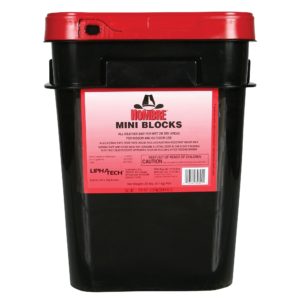 Hombre mini blocks are an ideal choice as the foundation for biosecurity rodent control programs. Formulated with Difethialone, a single feed, second-generation anticoagulant. Mice, roof rats and Norway rats are readily attracted to Hombre mini blocks. Blocks are designed with a center hole for securing to prevent rodents from translocating rodenticide into sensitive areas. MSDS
Hombre mini blocks are an ideal choice as the foundation for biosecurity rodent control programs. Formulated with Difethialone, a single feed, second-generation anticoagulant. Mice, roof rats and Norway rats are readily attracted to Hombre mini blocks. Blocks are designed with a center hole for securing to prevent rodents from translocating rodenticide into sensitive areas. MSDS -
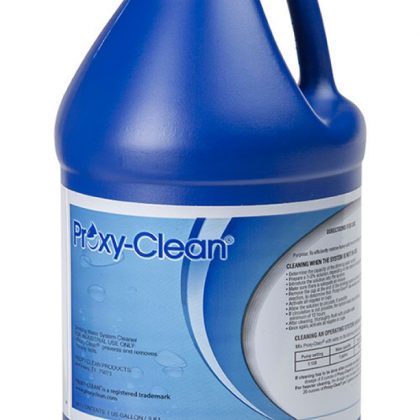 Proxy-Clean is a stabilized hydrogen peroxide based product specially formulated to remove and prevent heavy soils in livestock operations of any size. Proxy-Clean utilizes a proprietary stabilizer that is an active ingredient not found in any other product. The stabilizers used in other hydrogen peroxide products just allow them to be shelf stable. Proxy-Clean’s proprietary stabilizer acts as a decomposition catalyst allowing Proxy-Clean to do a complete cleaning on water lines and watering systems. Active IngredientsStabilized Hydrogen peroxide: 50% W/W.
Proxy-Clean is a stabilized hydrogen peroxide based product specially formulated to remove and prevent heavy soils in livestock operations of any size. Proxy-Clean utilizes a proprietary stabilizer that is an active ingredient not found in any other product. The stabilizers used in other hydrogen peroxide products just allow them to be shelf stable. Proxy-Clean’s proprietary stabilizer acts as a decomposition catalyst allowing Proxy-Clean to do a complete cleaning on water lines and watering systems. Active IngredientsStabilized Hydrogen peroxide: 50% W/W.Directions For Use
With Animals Present Mix Proxy-Clean with water to create the following stock solutions:
Discontinue use of any medication, chlorine or sanitizer when administering Proxy Clean. Resume the use of chlorine or other sanitizers after Proxy Clean treatment is finished. For routine sanitation use Proxy Clean at 25-50ppm in the drinking water (use test strips to measure concentration). Between 2 Lots/No Animals Present Fill the water lines with a Proxy Clean/water solution using the following options: Option 1: Use a 1:100 or 1:128 medicator to fill the water lines with a 1% or 0.78% solution of Proxy Clean. Allow the solution to remain in the water lines for a minimum of 48 hours before flushing. Option 2: Use a 3:100 medicator to fill the water lines with a 3% solution of Proxy Clean. Allow the solution to remain in the water lines for a minimum of 12 hours before flushing. When using Proxy Clean make sure that there is an adequate air release from your water system.Pump Water Proxy Clean Days 1 & 2 3 & 4 5 & 6 7-10 1:100 20L 250mL 350mL 475mL 600mL 1:128 20L 320mL 450mL 600mL 775mL Storage & Disposal
Please refer to MSDS sheet.Precautions & First Aid
Please refer to MSDS sheet. MSDS -
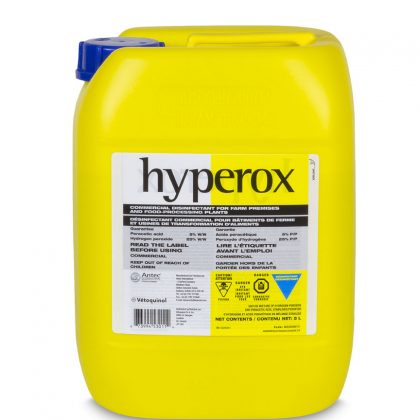 Hyperox consists of a blend of peracetic acid, hydrogen peroxide, acetic acid and surfactant in a long lasting stabilized aqueous solution. Hyperox has a broad spectrum biocidal activity and is non-tainting, does not leave residues after application and degrades to acetic acid, oxygen and water, each of which presents low environmental hazards. DIN 02240361 Active IngredientsPeracetic acid: 5% W/W Hydrogen peroxide: 25% W/W.
Hyperox consists of a blend of peracetic acid, hydrogen peroxide, acetic acid and surfactant in a long lasting stabilized aqueous solution. Hyperox has a broad spectrum biocidal activity and is non-tainting, does not leave residues after application and degrades to acetic acid, oxygen and water, each of which presents low environmental hazards. DIN 02240361 Active IngredientsPeracetic acid: 5% W/W Hydrogen peroxide: 25% W/W.Directions For Use
For best results, pre-clean all surfaces using a detergent before using Hyperox™. For routine disinfection of hard non-porous surfaces like floors, walls, concrete, plastic, stainless steel, glass, enameled surfaces, tile and any other hard non-porous surfaces which are not harmed by water: A 1:256 solution of Hyperox™ (1 part of Hyperox™ in 255 parts of water) is recommended for terminal disinfection. In farm premises: Remove all poultry, livestock and feeds from premises during disinfection. Remove all manure, litter and droppings from floors, walls, and surfaces of facilities occupied or traversed by poultry or livestock. Empty all troughs, racks, and other feeding and watering appliances. Using a pressure washer or mechanical sprayer, saturate surfaces with the solution at a rate of 300 mL per square meter (10 minute minimum contact time) and allow surfaces to dry before restocking. Ventilate building, coops and other closed spaces. All treated feed racks, mangers, troughs, automatic feeders, fountains, and waterers must be thoroughly rinsed with potable water prior to reuse. In food-processing plants: For food contact surfaces, rinse thoroughly with potable water after treatment with Hyperox™. For disinfection of equipment: A 1:128 solution of Hyperox™ (1 part of Hyperox™ in 127 parts of water) is recommended for cleaning and disinfecting equipment (such as buckets and utensils). Remove heavy soil from equipment to be treated. Allow disinfectant solution to remain in contact with the equipment for at least 10 minutes. Any milking equipment or equipment in contact with food where the product has been used should be flushed with potable water prior to reuse. For disinfection of foot and wheel dips: Foot and wheel dips disinfection can be made using a 1:128 solution of Hyperox™ (1 part of Hyperox™ in 127 parts of water). Boots and wheels should be immersed for at least one minute, so as to completely wet surfaces and allowed to air dry. Change foot or wheel dips’ solution when soiled or daily. For disinfection of water systems: A 1:256 solution of Hyperox™ (1 part of Hyperox™ in 255 parts of water) is recommended for water systems disinfection. Drain the system and fill with the solution for a 10 minute contact time. Drain and flush the water lines with potable water after disinfection. For disinfection by fogging: A 1:10 solution of Hyperox™ (1 part of Hyperox™ in 9 parts of water) is recommended for fogging. Use a thermal or mechanical fogging machine and apply at the rate of 17 mL per cubic meter. Leave for 30 minutes and vent for 30 minutes to 1 hour before re-entry.Storage
Store in the original container in a cool, well-ventilated dry room. Keep product away from sources of heat and combustible material. Avoid direct sunlight. Store away from food, feed or other pesticides. Containers must be stored upright only (do not block cap vent).Disposal
Do not reuse container. Follow provincial instructions for any additional cleaning of the container prior to its disposal. Make the empty container unsuitable for further use. Dispose of the container in accordance with provincial requirements. For information on the disposal of unused, unwanted product and the cleanup of spills, contact the provincial regulatory agency or the manufacturer.Precautions
KEEP OUT OF REACH OF CHILDREN: Oxidizing agent, corrosive to the eyes and skin. Do not inhale vapours given off by the product. Harmful or fatal if swallowed. Do not get in eyes, on skin, or on clothing. Wash hands, face and exposed skin before eating, drinking, or smoking, and after leaving the work area. Remove contaminated clothing and wash clothing before reuse. Avoid all contact by mouth, with skin or eyes. Accidental splashes on exposed skin or eyes should be washed off immediately with plenty of water. Wear suitable protective clothing (e.g. aprons, coveralls, complete footwear, etc.), chemical resistant gloves (e.g. nitrile or butyle rubber) and face protection (e.g. face shield, goggles, mask, etc.) when handling the concentrate and during application of product. When applying product by spraying or fogging, wear chemical resistant respirator. Do not remain in treated areas. Ensure proper ventilation after sealed areas have been treated. Do not contaminate food, feed or water troughs. Any treated surface or utensils that may contact food or feed products should be washed thoroughly with potable water after disinfection and before reuse. Do not return unused concentrate to the container in order to avoid possibility of contamination. TOXICOLOGICAL INFORMATION: Hyperox™ is an oxidizing agent and is corrosive and irritant. It can cause severe burns. Treat symptomatically. FIRST AID: Eye contact: If the product or its dilutions are splashed into the eye, rinse immediately with plenty of water or buffered eyewash. Remove any contact lenses. Seek medical advice immediately. Skin contact: Rinse any product off the skin immediately with water. Remove contaminated clothing and wash with water. Seek medical advice immediately. Ingestion: Allow patient to drink water if conscious, but do not induce vomiting. Rinse mouth out with water. Seek medical advice immediately. Inhalation: Remove affected person to fresh air. Keep upper body raised. Keep warm and in a stable position. Seek medical advice immediately. MSDS -
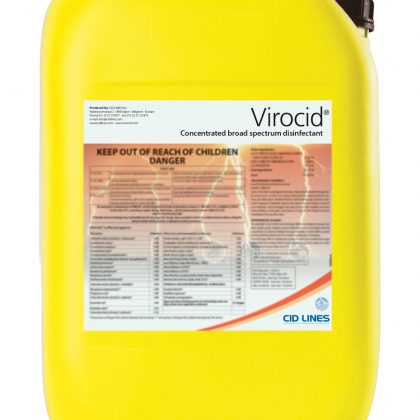 Virocid is a highly concentrated and broad spectrum disinfectant for use in food processing establishments, slaughter houses and livestock industries. Virocid is effective against: viruses, bacteria and fungi. Effective at rates as low as 0.25% (1:400). DIN 02239726 Active Ingredients
Virocid is a highly concentrated and broad spectrum disinfectant for use in food processing establishments, slaughter houses and livestock industries. Virocid is effective against: viruses, bacteria and fungi. Effective at rates as low as 0.25% (1:400). DIN 02239726 Active IngredientsAlkyl (40% C12, 50% C14, 10% C16) dimethyl benzyl ammonium chloride 17.06% Didecyl dimethyl ammonium chloride 7.80% Glutaraldehyde 10.725% Directions For Use
To disinfect hard non-porous surfaces (livestock equipment, floors, walls, table tops, counter tops), apply a 0.25% (1:400) solution to thoroughly wet surface. Spray the surface and let stand for 10 minutes. Virocid is a concentrate that can be used with a mop and bucket, trigger sprayers, sponge, or by soaking. Heavily soiled surfaces should be precleaned prior to disinfection. All food contact surfaces must be thoroughly rinsed with potable water after disinfection.Storage
Store in original container, in a dry, cool place. Do not store in food processing environments.Disposal
1. Rinse the emptied container thoroughly and add the rinsings to the treatment site. 2. Follow local instructions for any required additional cleaning of the container prior to disposal. 3. Make the empty container unsuitable for further use. 4. Disposal of product and packaging: The product and packaging must be disposed of in accordance with local requirements.Precautions
KEEP OUT OF REACH OF CHILDREN. Danger - Corrosive to eyes. Do not get in eyes, on skin or clothing. Use appropriate clothes, gloves and eye protection. Harmful if swallowed. Avoid contamination of food.First Aid
In case of contact, immediately flush eyes or skin with plenty of water for at least 15 minutes. For eyes, call a physician. Remove and wash contaminated clothing before reuse. If inhaled, breathe fresh air and consult a physician. If swallowed, do NOT induce vomiting. Call a physician or poison control centre immediately. MSDS -
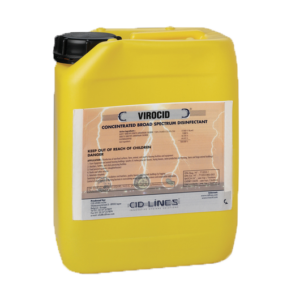 Virocid is a highly concentrated and broad spectrum disinfectant for use in food processing establishments, slaughter houses and livestock industries. Virocid is effective against: viruses, bacteria and fungi. Effective at rates as low as 0.25% (1:400). DIN 02239726 Active Ingredients
Virocid is a highly concentrated and broad spectrum disinfectant for use in food processing establishments, slaughter houses and livestock industries. Virocid is effective against: viruses, bacteria and fungi. Effective at rates as low as 0.25% (1:400). DIN 02239726 Active IngredientsAlkyl (40% C12, 50% C14, 10% C16) dimethyl benzyl ammonium chloride 17.06% Didecyl dimethyl ammonium chloride 7.80% Glutaraldehyde 10.725% Directions For Use
To disinfect hard non-porous surfaces (livestock equipment, floors, walls, table tops, counter tops), apply a 0.25% (1:400) solution to thoroughly wet surface. Spray the surface and let stand for 10 minutes. Virocid is a concentrate that can be used with a mop and bucket, trigger sprayers, sponge, or by soaking. Heavily soiled surfaces should be precleaned prior to disinfection. All food contact surfaces must be thoroughly rinsed with potable water after disinfection.Storage
Store in original container, in a dry, cool place. Do not store in food processing environments.Disposal
1. Rinse the emptied container thoroughly and add the rinsings to the treatment site. 2. Follow local instructions for any required additional cleaning of the container prior to disposal. 3. Make the empty container unsuitable for further use. 4. Disposal of product and packaging: The product and packaging must be disposed of in accordance with local requirements.Precautions
KEEP OUT OF REACH OF CHILDREN. Danger - Corrosive to eyes. Do not get in eyes, on skin or clothing. Use appropriate clothes, gloves and eye protection. Harmful if swallowed. Avoid contamination of food.First Aid
In case of contact, immediately flush eyes or skin with plenty of water for at least 15 minutes. For eyes, call a physician. Remove and wash contaminated clothing before reuse. If inhaled, breathe fresh air and consult a physician. If swallowed, do NOT induce vomiting. Call a physician or poison control centre immediately. MSDS -
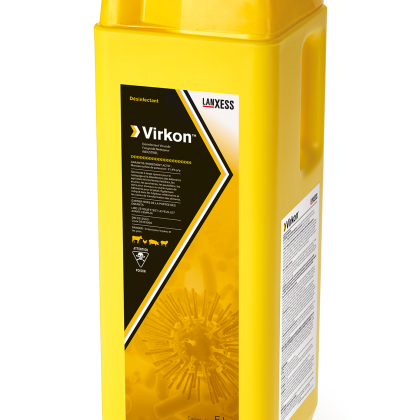 Virkon™ is a disinfectant, possessing wide spectrum virucidal, bactericidal and fungicidal activity. The effectiveness of Virkon™ is further enhanced by its excellent detergent properties, so that clean disease-free surfaces can be achieved. Virkon™ is unique in its composition. Its activity is based on a buffered synergized acid peroxygen system containing a high percentage of surfactant. Virkon™ can be used on all surfaces and in all situations. Once diluted in a 1% solution, Virkon™ is of low toxicity, non-tainting, and non-irritant. Because of its high detergency and mode of action, Virkon™ can be used in an exceptional variety of situations for effective cleaning and virucidal disinfection in a single operation. Virkon™ can be applied manually or through all types of cleaning and spraying equipment. Readily soluble in lukewarm water giving a clear pink solution. Virkon™ consists mainly of inorganic salts. DIN 02125021 Active Ingredients
Virkon™ is a disinfectant, possessing wide spectrum virucidal, bactericidal and fungicidal activity. The effectiveness of Virkon™ is further enhanced by its excellent detergent properties, so that clean disease-free surfaces can be achieved. Virkon™ is unique in its composition. Its activity is based on a buffered synergized acid peroxygen system containing a high percentage of surfactant. Virkon™ can be used on all surfaces and in all situations. Once diluted in a 1% solution, Virkon™ is of low toxicity, non-tainting, and non-irritant. Because of its high detergency and mode of action, Virkon™ can be used in an exceptional variety of situations for effective cleaning and virucidal disinfection in a single operation. Virkon™ can be applied manually or through all types of cleaning and spraying equipment. Readily soluble in lukewarm water giving a clear pink solution. Virkon™ consists mainly of inorganic salts. DIN 02125021 Active IngredientsPotassium monopersulfate 21.4% W/W Directions For Use
In agricultural buildings: animals must be removed from the premise during disinfection. In food processing plants: for food contact surfaces, rinse thoroughly with potable water after disinfection. 1. FOR CLEANING AND DISINFECTION OF SURFACES AND EQUIPMENT: In agricultural buildings Remove all animals from premises. Remove all litter and manure from floors, walls, and other surfaces of barns and equipment. Brush and blow dust from fans, motors, louvers and electrical equipment. For terminal cleaning and disinfection, saturate all surfaces with a 1% w/v solution of Virkon™, using a pressure washer or a fogger. Virkon™ should remain in contact with the surface to be disinfected for at least 10 minutes. Scrub heavily soiled utensils and soak in a 1% w/v solution of Virkon™ for 10 minutes (do not exceed 30 minutes for metal objects). In veterinary hospitals Remove heavy soil deposits then thoroughly wet surfaces to be disinfected with a 1% w/v solution of Virkon™, using a mop, sponge or cloth, as well as by spraying. A minimum contact time of 10 minutes is required. For laboratory equipment and bowls, scrub heavily soiled utensils and soak in a 1% w/v solution of Virkon™ for a minimum of 10 minutes (do not exceed 30 minutes for metal objects). IMPORTANT NOTE: In animal premises where there has been a disease outbreak and/or the mortality/morbidity rates are higher than normal and the causative agent has been determined by a pathology laboratory to be one of those listed in Table 1, the contact time/dilution rate indicated should be used. In food processing plants Remove all debris and other deposits from surfaces. Then, thoroughly wet surfaces to be disinfected with a 1% w/v solution of Virkon™, using a mop, sponge or cloth, as well as by spraying. A minimum contact time of 10 minutes is required. For food contact surfaces, rinse thoroughly with potable water after treatment with Virkon™. For a complete listing of microorganisms against which Virkon™ is effective, refer to the Efficacy Charts 2, 3, and 4. 2. FOR AERIAL DISINFECTION: To replace dangerous and ineffective formalin fumigation in empty farm buildings and veterinary hospitals. Shutdown the ventilation system during the disinfection. Use a mechanical fogging machine as part of terminal disinfection routine with a 1% w/v solution of Virkon™. Apply at a rate of one litre of solution per 100 m3 with particle size not exceeding 70 microns in order to get a minimal contact time of 10 minutes with microorganisms in the air. Leave the room during the fogging. Users and animals may re-enter the treated area once the fog has dispersed. No rinsing is required after fogging. 3. SANITIZING DRINKING WATER SYSTEM: For sanitizing drinking water system at terminal clean out, use a 1.0% w/v solution of Virkon™. Dose header tank and drain system. Wait at least 10 minutes before draining again. DILUTION INSTRUCTIONS1) Select the quantity of disinfectant solution required. 2) Choose appropriate dilution rate. 3) Measure out the amount of Virkon™ indicated using the graduated measuring scoop provided. 4) Add Virkon™ to warm water and stir. There is a 20% loss of activity of 1% solutions of Virkon™ after 14 days in 350 ppm hard water.Dilution rate required (w/v) Quantity of disinfectant solution required 3.0% 2.0% 1.0% 0.5% 0.2% Quantity of Virkon™ required 30 g 20 g 10 g 5 g 2 g 1 Litre 150 g 100 g 50 g 25 g 10 g 5 Litres 300 g 200 g 100 g 50 g 20 g 10 Litres 750 g 500 g 250 g 125 g 50 g 25 Litres Storage
Store between 15°C and 25°C in a dry place in tightly sealed containers.Disposal
1) Rinse the emptied container thoroughly and add the rinsings to treatment site. 2) Follow provincial instructions for any required additional cleaning of the container prior to its disposal. 3) Make the empty container unsuitable for further use. 4) Dispose of the container in accordance with provincial requirements. 5) For information on the disposal of unused, unwanted product and the cleanup of spills, contact the Provincial Regulatory Agency or the Manufacturer.Precautions
Keep out of reach of children. Powder irritating to eyes, skin and mucous membranes. May be harmful if swallowed or inhaled. Do not get powder in eyes. Avoid contact of powder with skin. Handle in such a way as to minimize dust release. Do not mix with other chemicals. When mixing the solution, wear goggles, chemical-resistant gloves, and a mask. It is recommended that workers wear overalls, goggles and a mask when applying Virkon™ solution with a hand-held fogger or a pressure washer.First Aid
Eyes: Irrigate with plenty of water. Skin: When in powder, remove contaminated clothing. Wash with soap and water. Not hazardous when in solution. Ingestion: When in powder, wash mouth with plenty of water. Drink plenty of water. Do not induce vomiting. Seek medical advice. If in solution, rinse mouth out with water. Inhalation: When in powder, if symptoms of coughing, choking, wheezing are troublesome, remove to fresh air and seek medical advice. MSDS -
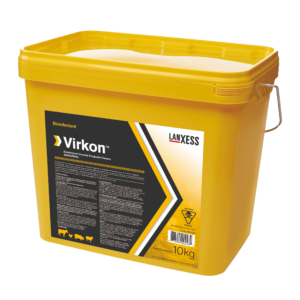 Virkon™ is a disinfectant, possessing wide spectrum virucidal, bactericidal and fungicidal activity. The effectiveness of Virkon™ is further enhanced by its excellent detergent properties, so that clean disease-free surfaces can be achieved. Virkon™ is unique in its composition. Its activity is based on a buffered synergized acid peroxygen system containing a high percentage of surfactant. Virkon™ can be used on all surfaces and in all situations. Once diluted in a 1% solution, Virkon™ is of low toxicity, non-tainting, and non-irritant. Because of its high detergency and mode of action, Virkon™ can be used in an exceptional variety of situations for effective cleaning and virucidal disinfection in a single operation. Virkon™ can be applied manually or through all types of cleaning and spraying equipment. Readily soluble in lukewarm water giving a clear pink solution. Virkon™ consists mainly of inorganic salts. DIN 02125021 Active Ingredients
Virkon™ is a disinfectant, possessing wide spectrum virucidal, bactericidal and fungicidal activity. The effectiveness of Virkon™ is further enhanced by its excellent detergent properties, so that clean disease-free surfaces can be achieved. Virkon™ is unique in its composition. Its activity is based on a buffered synergized acid peroxygen system containing a high percentage of surfactant. Virkon™ can be used on all surfaces and in all situations. Once diluted in a 1% solution, Virkon™ is of low toxicity, non-tainting, and non-irritant. Because of its high detergency and mode of action, Virkon™ can be used in an exceptional variety of situations for effective cleaning and virucidal disinfection in a single operation. Virkon™ can be applied manually or through all types of cleaning and spraying equipment. Readily soluble in lukewarm water giving a clear pink solution. Virkon™ consists mainly of inorganic salts. DIN 02125021 Active IngredientsPotassium monopersulfate 21.4% W/W Directions For Use
In agricultural buildings: animals must be removed from the premise during disinfection. In food processing plants: for food contact surfaces, rinse thoroughly with potable water after disinfection. 1. FOR CLEANING AND DISINFECTION OF SURFACES AND EQUIPMENT: In agricultural buildings Remove all animals from premises. Remove all litter and manure from floors, walls, and other surfaces of barns and equipment. Brush and blow dust from fans, motors, louvers and electrical equipment. For terminal cleaning and disinfection, saturate all surfaces with a 1% w/v solution of Virkon™, using a pressure washer or a fogger. Virkon™ should remain in contact with the surface to be disinfected for at least 10 minutes. Scrub heavily soiled utensils and soak in a 1% w/v solution of Virkon™ for 10 minutes (do not exceed 30 minutes for metal objects). In veterinary hospitals Remove heavy soil deposits then thoroughly wet surfaces to be disinfected with a 1% w/v solution of Virkon™, using a mop, sponge or cloth, as well as by spraying. A minimum contact time of 10 minutes is required. For laboratory equipment and bowls, scrub heavily soiled utensils and soak in a 1% w/v solution of Virkon™ for a minimum of 10 minutes (do not exceed 30 minutes for metal objects). IMPORTANT NOTE: In animal premises where there has been a disease outbreak and/or the mortality/morbidity rates are higher than normal and the causative agent has been determined by a pathology laboratory to be one of those listed in Table 1, the contact time/dilution rate indicated should be used. In food processing plants Remove all debris and other deposits from surfaces. Then, thoroughly wet surfaces to be disinfected with a 1% w/v solution of Virkon™, using a mop, sponge or cloth, as well as by spraying. A minimum contact time of 10 minutes is required. For food contact surfaces, rinse thoroughly with potable water after treatment with Virkon™. For a complete listing of microorganisms against which Virkon™ is effective, refer to the Efficacy Charts 2, 3, and 4. 2. FOR AERIAL DISINFECTION: To replace dangerous and ineffective formalin fumigation in empty farm buildings and veterinary hospitals. Shutdown the ventilation system during the disinfection. Use a mechanical fogging machine as part of terminal disinfection routine with a 1% w/v solution of Virkon™. Apply at a rate of one litre of solution per 100 m3 with particle size not exceeding 70 microns in order to get a minimal contact time of 10 minutes with microorganisms in the air. Leave the room during the fogging. Users and animals may re-enter the treated area once the fog has dispersed. No rinsing is required after fogging. 3. SANITIZING DRINKING WATER SYSTEM: For sanitizing drinking water system at terminal clean out, use a 1.0% w/v solution of Virkon™. Dose header tank and drain system. Wait at least 10 minutes before draining again. DILUTION INSTRUCTIONS1) Select the quantity of disinfectant solution required. 2) Choose appropriate dilution rate. 3) Measure out the amount of Virkon™ indicated using the graduated measuring scoop provided. 4) Add Virkon™ to warm water and stir. There is a 20% loss of activity of 1% solutions of Virkon™ after 14 days in 350 ppm hard water.Dilution rate required (w/v) Quantity of disinfectant solution required 3.0% 2.0% 1.0% 0.5% 0.2% Quantity of Virkon™ required 30 g 20 g 10 g 5 g 2 g 1 Litre 150 g 100 g 50 g 25 g 10 g 5 Litres 300 g 200 g 100 g 50 g 20 g 10 Litres 750 g 500 g 250 g 125 g 50 g 25 Litres Storage
Store between 15°C and 25°C in a dry place in tightly sealed containers.Disposal
1) Rinse the emptied container thoroughly and add the rinsings to treatment site. 2) Follow provincial instructions for any required additional cleaning of the container prior to its disposal. 3) Make the empty container unsuitable for further use. 4) Dispose of the container in accordance with provincial requirements. 5) For information on the disposal of unused, unwanted product and the cleanup of spills, contact the Provincial Regulatory Agency or the Manufacturer.Precautions
Keep out of reach of children. Powder irritating to eyes, skin and mucous membranes. May be harmful if swallowed or inhaled. Do not get powder in eyes. Avoid contact of powder with skin. Handle in such a way as to minimize dust release. Do not mix with other chemicals. When mixing the solution, wear goggles, chemical-resistant gloves, and a mask. It is recommended that workers wear overalls, goggles and a mask when applying Virkon™ solution with a hand-held fogger or a pressure washer.First Aid
Eyes: Irrigate with plenty of water. Skin: When in powder, remove contaminated clothing. Wash with soap and water. Not hazardous when in solution. Ingestion: When in powder, wash mouth with plenty of water. Drink plenty of water. Do not induce vomiting. Seek medical advice. If in solution, rinse mouth out with water. Inhalation: When in powder, if symptoms of coughing, choking, wheezing are troublesome, remove to fresh air and seek medical advice. MSDS

